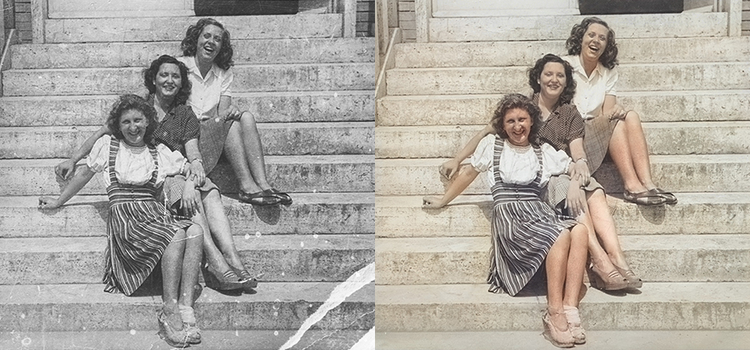PHOTOGRAPHY
Resurrect old images with photo restoration in Adobe Photoshop.
Fix old family photos fast with easy digital restoration features.

PHOTOGRAPHY
Fix old family photos fast with easy digital restoration features.
JUMP TO SECTION
How to restore old photos in Photoshop
Transform vintage photos back to their former glory in one step with the Photo Restoration Neural Filter. Find it under Filter › Neural Filters › Photo Restoration. Then fine-tune image enhancement, facial enhancement and scratch reduction sliders to get the result just right.
Photo restoration services or enhancement services by professional retouchers can get expensive fast. Luckily you don’t always need to take your old photographs to a digital photo repair specialist to give them the love they deserve. You can enhance, retouch and colourise black-and-white images — get high-quality results using a few simple photo editing techniques in Adobe Photoshop.

1. Import your old photo into Photoshop
Bring your scanned image into Photoshop. Your image will be your background layer. Lock it and make no adjustments to this layer.
2. Create a new layer.
This empty layer is where you will make all your adjustments. When you place your adjustments on a separate layer from the original image it means you can make non-destructive edits — they will not alter the original image, just lay adjustments on top of it.

3. Apply the Photo Restoration Filter.
Go to Filter › Neural Filters › Photo Restoration. Download the filter and apply it to see instant improvements in your photo’s clarity. Adjust the sliders for image enhancement, enhance face and scratch reduction to fine-tune the intensity of the filter.
4. Make additional fixes with the Spot Healing Brush and Clone Stamp tool.
For remaining damage you’d like to fix, go to the options in the top toolbar, click Sample All Layers and select Content Aware from the available types. Then use the Spot Healing Brush to dab over areas you want to heal. If unwanted marks still remain, cover them with the Clone Stamp tool. (Select “Current layers and below” as you use this tool so you can work nondestructively.)

5. Colourise your photo, if desired.
If your old photo is black and and white or sepia-toned, add colour quickly and easily. Create a new layer that contains all your previous layers by clicking Ctrl+Alt+Shift+E on Windows or Command+Option+Shift+E on Mac. Then click Filter › Neural Filters › Colourise. Set the blending mode of your new colourised layer to Colour so you can make non-destructive edits.
6. Export your restored photo.
You can save your image as a JPG, TIFF, PNG or other image file format of your choice.

Create gorgeous images, rich graphics and incredible art.
Sometimes formerly vibrant photos have lost a little bit of their lustre, colour and character due to age and exposure to the elements. Fortunately, Photoshop has several tools for bringing them back to life.
Auto Colour is a tool that creates colours for the image based on what’s already there.
Adjustment layers have sliders you can use to adjust the intensity and type of colour within an image.

Adjust the level of shadows, blacks and midtones with the Levels panel.
Lastly, adjust the sharpness and middle tones with the Clarity slider to make your newly restored photos look just right.
To get the most out of your photo enhancements, follow these expert tips.
Photoshop expert and educator Jesús Ramirez recommends you use a digital pen and tablet with the Spot Healing Brush and Clone Stamp tools. It’s much easier to make natural strokes and fine adjustments with a pen than with a mouse or track pad.
“It’s better if you have a small brush and make small strokes instead of painting over giant areas all at once,” says Ramirez. This helps your adjustments look as natural as possible.
Instead of keeping all your adjustments on a single layer, Ramirez recommends separating them out to keep things organised. The more you can organise different adjustments, the easier it will be to go back and make specific edits later. “You might have one layer for the face, one for the hair, one for the background and so on,” says Ramirez about working on a portrait.

In many cases, the Neural Filter will do an excellent job of colourising your photo all on its own. But if you want to take your colorisation techniques to the next level, you can use the Colour Balance tool to adjust the tones in your image. You can make a Curves adjustment layer to control contrast. Or you can let Photoshop do the work for you. To do this, create a Curves adjustment layer, select Auto Colour Correction Options and click Bind Dark & Light Colours. Make sure to select Snap Neutral Midtones, then click OK.
Don’t let time diminish the beauty of vintage photos. Use these simple tips to ensure classic images can inspire nostalgia for years to come.
Contributors
Based on your location, we think you may prefer the United States website, where you'll get regional content, offerings, and pricing.